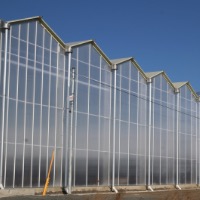Measurement of longwave radiative properties of energy-saving greenhouse screens

Published:30 September 2021
Abstract Views: 1089
PDF: 512
HTML: 12
HTML: 12
Publisher's note
All claims expressed in this article are solely those of the authors and do not necessarily represent those of their affiliated organizations, or those of the publisher, the editors and the reviewers. Any product that may be evaluated in this article or claim that may be made by its manufacturer is not guaranteed or endorsed by the publisher.
All claims expressed in this article are solely those of the authors and do not necessarily represent those of their affiliated organizations, or those of the publisher, the editors and the reviewers. Any product that may be evaluated in this article or claim that may be made by its manufacturer is not guaranteed or endorsed by the publisher.
Similar Articles
- Daniele Torreggiani, Alberto Barbaresi, Francesca Dallacasa, Patrizia Tassinari, Effects of different architectural solutions on the thermal behaviour in an unconditioned rural building. The case of an Italian winery , Journal of Agricultural Engineering: Vol. 49 No. 1 (2018)
- Qazeem Opeyemi Ogunlowo, Adedayo Afeez Azeez, Wook Ho Na, Anis Rabiu, Misbaudeen Aderemi Adesanya, Ezatullah Zakir, John Ademola Ijadunola, Bukola Olanrewaju Afolabi, Babajide Saheed Kosemani, Titus Adeyinka Ilori, Hyun-Woo Lee, Analysis of microclimate temperature and relative humidity distribution of local poultry house in a subtropical area of Nigeria , Journal of Agricultural Engineering: Vol. 55 No. 2 (2024)
- Timothy Denen Akpenpuun, Wook Ho Na, Qazeem Opeyemi Ogunlowo, Anis Rabiu, Misbaudeen Aderemi Adesanya, Kwame Sasu Addae, Hyeon Tae Kim, Hyun-Woo Lee, Effect of glazing configuration as an energy-saving strategy in naturally ventilated greenhouses for strawberry (Seolhyang sp.) cultivation , Journal of Agricultural Engineering: Vol. 52 No. 2 (2021)
- Francesco Barreca, Pasquale Praticò, Giuseppe Davide Cardinali, A low-energy storage container for food and agriculture products , Journal of Agricultural Engineering: Vol. 52 No. 3 (2021)
- Hui Yang, Yuhao Li, Chengguo Fu, Rongxian Zhang, Haibo Li, Yipeng Feng, Yaqi Zhang, Hongbin Cong, Fuquan Nie, Research on inspection route of hanging environmental robot based on computational fluid dynamics , Journal of Agricultural Engineering: Vol. 55 No. 2 (2024)
- Zanbin Zhu, Yubin Li, Shoufu Gong, Design and experiment of Internet-of-Things cooling system in glass greenhouse based on computational fluid dynamics simulation , Journal of Agricultural Engineering: Vol. 54 No. 3 (2023)
- Alessandro D'Emilio, Simona M.C. Porto, Giovanni Cascone, Marco Bella, Marco Gulino, Mitigating heat stress of dairy cows bred in a free-stall barn by sprinkler systems coupled with forced ventilation , Journal of Agricultural Engineering: Vol. 48 No. 4 (2017)
- Valentina Giovenzana, Roberto Beghi, Riccardo Guidetti, Massimiliano Luison, Tiziana Nardi, Evaluation of energy savings in white winemaking: impact of temperature management combined with specific yeasts choice on required heat dissipation during industrial-scale fermentation , Journal of Agricultural Engineering: Vol. 54 No. 3 (2023)
- Shahad Al-Rikabi, Enrica Santolini, Beatrice Pulvirenti, Marco Bovo, Alberto Barbaresi, Daniele Torreggiani, Patrizia Tassinari, Definition of thermal comfort of crops within naturally ventilated greenhouses , Journal of Agricultural Engineering: Vol. 54 No. 4 (2023)
- Senanur Durgut Malçok, Azime Özkan Karabacak, Cüneyt Tunçkal, Canan Ece Tamer, Application of response surface methodology for optimisation of Cornelian cherry - Capia pepper leather dried in a heat pump drying system , Journal of Agricultural Engineering: Vol. 54 No. 3 (2023)
You may also start an advanced similarity search for this article.

 https://doi.org/10.4081/jae.2021.1209
https://doi.org/10.4081/jae.2021.1209 






